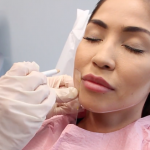It’s safe to say that beauty routines nowadays involve more than just luxurious creams, serums, and a weekly facial. Every few months or so, anyone could pay his or her dermatologist’s office a visit and leave 15 minutes later with dramatically tighter, firmer skin. And how often do we hear about those wanting to look like their favorite celebrities? It’s as if the pursuit of beauty has now become society’s new adopted lifestyle. Even statistics show how surgeries and other cosmetic treatments are gaining popularity. According to the American Society of Plastic Surgeons (ASPS), more than 17.7 million surgical and minimally invasive cosmetic procedures were performed in the United States in 2018. That’s a 2% increase from 2017. It is the goal of aesthetic dermatology after all, to help their growing number of clients enhance their beauty and achieve natural-looking results. But as people continue to modify their appearance while still aiming to look natural, how do we continue to define what is “natural” in the context of a physical appearance that is continuously getting altered?
How We Evaluate Our Appearance
The problem with people consistently undergoing cosmetic procedures is the possibility of not remembering how they originally look like. They tend to come back for more treatments but cannot see the improvement or difference from their “before” photos. When a patient’s perceptions of the changes achieved after a series of cosmetic procedures become skewed, this phenomenon is what is referred to as “Perception Drift,” as first coined and published by our very own Dr. Sabrina Fabi.
Let’s say a patient gets a filler treatment to define her cheekbones. After the treatment, she decides she’s not happy with the contours of her jawline, only to recognize that her lips look too thin in proportion to her cheeks. Once fillers are all in place, she then realizes she has a double chin. She is exhibiting a case of perception drift –her perception of herself changes as each of her flaws is addressed, making her consistently dissatisfied with her appearance.
Here at Cosmetic Laser Dermatology in San Diego, our world-renowned board-certified dermatologists who have over 100 years of combined experience and over 100,000 satisfied patients, make it part of their mission to help patients manage their expectations and look like the best versions of themselves, giving a boost to their confidence and self-esteem.
Perceived Flaws
After cosmetic procedures, it’s not only our face or body that changes, but so can our evaluation process of how we look. It is our instinct to do local processing on a small feature of the face –a pair of too thin lips, for example. The next step would be global processing of the entire face which examines how those lips look against your other facial features. Those who have Body Dysmorphia Disorder (BDD) –a psychiatric disorder characterized by being excessively preoccupied with one’s perceived physical flaws –tend to have increased local processing with some degree of global processing. In other words, they’re more likely to give more focus on the details of their appearance.
When a perceived flaw is treated, change is created in the appearance which enhances local processing. As a result, previously ignored flaws become one’s new fixation, setting a new baseline. So, as these perceived flaws are fixated on and become addressed, the patient will fall into an endless cycle of developing new baselines. Eventually, patients who initially wanted a “natural’ look no longer look like themselves.
Factors That Could Influence A Patient’s Perception Of Their Perceived Flaws
There are various reasons why patients become overly focused on their perceived flaws, causing them to be unable to accurately process their appearance.
- Social Media – Our selfie-obsessed culture can impact one’s self-esteem. Filters on Snapchat, Instagram, and Facetune which create these flawless-looking photos can contribute to a skewed perception of perceived flaws. In effect, users will feel insecure about the way they look, realizing they are not as attractive as their own filtered images. This could even lead to the feeling of inadequacy, or even be a trigger for developing BDD, depression, and eating disorders.
- Culture – Studies show that individuals from different cultures agree on which faces presented to them are more attractive.
- Systematic Differences in Preferences – These differences in preferences reflect differences in experience. For example, a study conducted by Peskin and Newell (2004) showed familiarity breeds attraction. The more exposure we have to certain faces, the more familiar we become to those faces, increasing their attractiveness. Another one by Rhodes et al. (2003) showed that the participants’ adaptation to consistent facial distortions shifted their judgement from what was most attractive toward the distortion.
 What Can Be Done To Help Avoid Perception Drift After Cosmetic Procedures?
What Can Be Done To Help Avoid Perception Drift After Cosmetic Procedures?
There are steps that can be taken to help nurture a healthier mindset for the patient.
- Use Photographs – Compare current photographs to the baseline photos taken prior to the patient’s cosmetic procedure. This way, he or she will be reminded of how they originally looked. This will not only validate the fact that improvements have been achieved, but will also avoid the possibility of local processing any remaining “perceived” imperfections.
- Use Visual Training Techniques – For BDD, one useful technique involves viewing the entire face and body in front of a full-length mirror while describing each body part objectively and nonjudgmentally.
- Help Form Realistic Expectations – Any qualified physician should understand and care about a patient’s concerns, lifestyle, and anatomical makeup. A long-term plan must be made in order to have the ability to forecast results, as multiple procedures will impact one another. Any provider of cosmetic treatments should also know when to stop. Constantly resetting a new baseline can lead to more perceived flaws. The physician must also make the patients believe that their goals are achievable and that it’s not a game of hit or miss.
Schedule An Appointment
Here at Cosmetic Laser Dermatology, it is our goal to help you discover your best self. Learn more about our multiple dermatology treatments and technologies that will give you natural-looking results without the need for surgery by scheduling an appointment with us. Contact our San Diego office by calling (858) 943-2113 today.
More Like This,
 The Importance of Going to a Dermatologist for Your Cosmetic Treatments
The Importance of Going to a Dermatologist for Your Cosmetic Treatments





